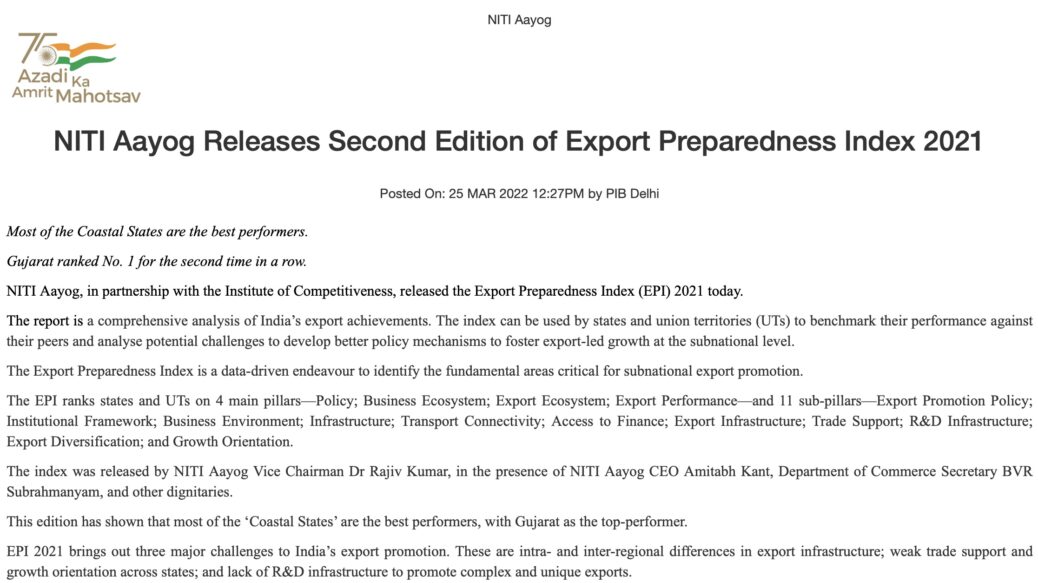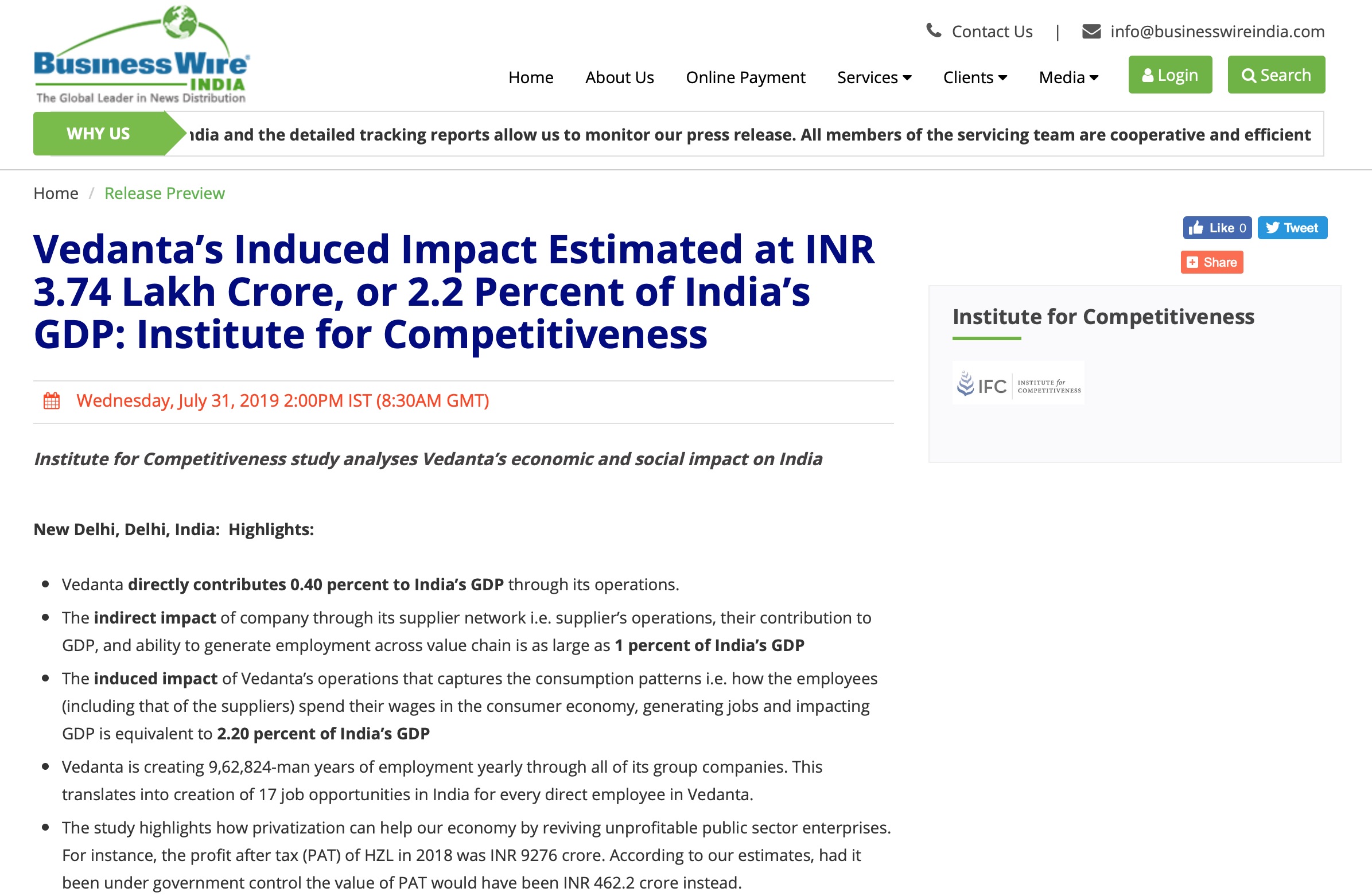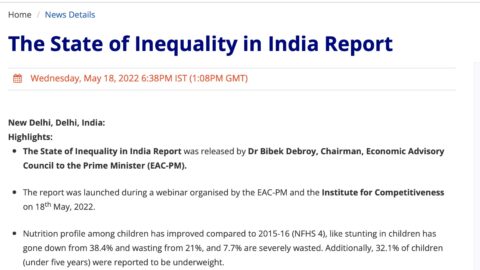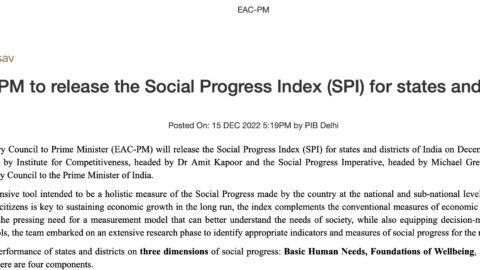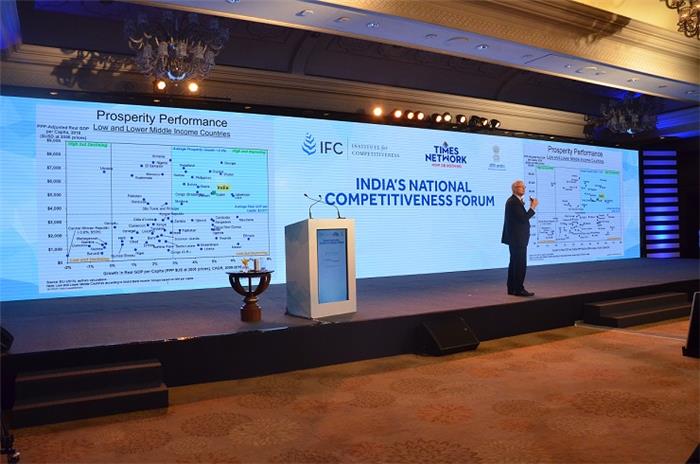Posted On: 25 MAR 2022 12:27PM by PIB Delhi
Most of the Coastal States are the best performers.
Gujarat ranked No. 1 for the second time in a row.
NITI Aayog, in partnership with the Institute of Competitiveness, released the Export Preparedness Index (EPI) 2021 today.
The report is a comprehensive analysis of India’s export achievements. The index can be used by states and union territories (UTs) to benchmark their performance against their peers and analyse potential challenges to develop better policy mechanisms to foster export-led growth at the subnational level.
The Export Preparedness Index is a data-driven endeavour to identify the fundamental areas critical for subnational export promotion.
The EPI ranks states and UTs on 4 main pillars—Policy; Business Ecosystem; Export Ecosystem; Export Performance—and 11 sub-pillars—Export Promotion Policy; Institutional Framework; Business Environment; Infrastructure; Transport Connectivity; Access to Finance; Export Infrastructure; Trade Support; R&D Infrastructure; Export Diversification; and Growth Orientation.
The index was released by NITI Aayog Vice Chairman Dr Rajiv Kumar, in the presence of NITI Aayog CEO Amitabh Kant, Department of Commerce Secretary BVR Subrahmanyam, and other dignitaries.
This edition has shown that most of the ‘Coastal States’ are the best performers, with Gujarat as the top-performer.
EPI 2021 brings out three major challenges to India’s export promotion. These are intra- and inter-regional differences in export infrastructure; weak trade support and growth orientation across states; and lack of R&D infrastructure to promote complex and unique exports.
The EPI’s primary goal is to instil competition among all Indian states (‘Coastal’, ‘Landlocked’, ‘Himalayan’, and ‘UTs/City-States’) to bring about favourable export-promotion policies, ease the regulatory framework to prompt subnational export promotion, create the necessary infrastructure for exports, and assist in identifying strategic recommendations for improving export competitiveness. It promotes competitive federalism and a fair contest among States/UTs.
The index can be a valuable tool for the government and policymakers in encouraging healthy competition among states and UTs, hence enhancing India’s standing in the global export market.
While releasing the report, NITI Aayog Vice Chairman Dr Rajiv Kumar remarked that EPI 2021 will help the states and UTs in a long way to plan and execute sound export-oriented policies for ensuring a conducive export ecosystem, to make maximum utilization of their export potential.
NITI Aayog CEO Amitabh Kant emphasized that the second edition of the index will be a significant catalyst for promoting competitive federalism and a fair contest among states and UTs in the global export landscape.
During the event, Department of Commerce Secretary B.V.R. Subrahmanyam highlighted that there is also a need to work continuously on strengthening our manufacturing and infrastructure ecosystems at the state/UT levels to ensure robust growth of exports in the future.
Framework:
The 4 pillars and the rationale behind their selection is given below:
- Policy: A comprehensive trade policy provides a strategic direction for exports and imports.
- Business Ecosystem: An efficient business ecosystem can help attract investments and create an enabling infrastructure for businesses to grow.
- Export Ecosystem: This pillar aims to assess the business environment, which is specific to exports.
- Export Performance: This is the only output-based pillar and examines the reach of export footprints of states and union territories.
Read the full report here: https://www.niti.gov.in/sites/default/files/2022-03/Final_EPI_Report_25032022.pdf
The Press Release could also be looked at https://pib.gov.in/PressReleasePage.aspx?PRID=1809531
***
DS/LP/AK
(Release ID: 1809531) Visitor Counter : 315
Read this release in: Gujarati

